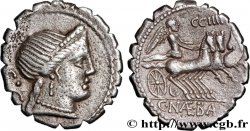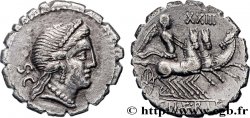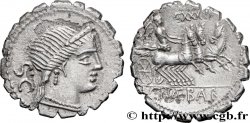v15_1483 - NAEVIA Denier serratus
MONNAIES 15 (2002)
Prezzo di inizio : 70.00 €
Valutazione : 150.00 €
Prezzo realizzato : 75.00 €
Numero di offerte : 2
Offerta maxima : 132.00 €
Prezzo di inizio : 70.00 €
Valutazione : 150.00 €
Prezzo realizzato : 75.00 €
Numero di offerte : 2
Offerta maxima : 132.00 €
Tipo : Denier serratus
Data: 79 AC.
Nome della officina / città: Rome ou Italie
Metallo : argento
Titolo in millesimi : + 950 ‰
Diametro : 19,5 mm
Asse di coniazione : 6 h.
Peso : 3,72 g.
Commenti sullo stato di conservazione:
Beau portrait. Bien centré des deux côtés. Patine de collection. Faiblesse de frappe sur le trige
N° nelle opere di riferimento :
Diritto
Titolatura diritto : S. C.
Descrittivo diritto : Tête diadémée de Vénus à droite.
Traduzione diritto : “Senatus Consulto”, (avec l’accord du Sénat).
Rovescio
Titolatura rovescio : CNÆ B(AL)B.
Descrittivo rovescio : Victoire dans un trige galopant à droite, tenant les rênes des deux mains à gauche ; au-dessus, marque de contrôle VII, (7).
Traduzione rovescio : “Cnæus [Nævius] Balbus”, (Gneius [Nævius] Balbus).
Commento
La représentation du trige est aussi rare dans les numismatiques gauloise que romaine. On trouve dans l'ouvrage de LA TOUR (LT. 10074, 10075 et 10085), les dessins de trois deniers copiés ou imités sur ce prototype par les Celtes du Danube. D'autre part, S. Scheers donne comme prototype du bronze véliocasse (LT. 7356), le denier de Jules César (RCV. 1402) avec Énée fuyant Troie. En réalité, la tête de Vénus de notre denier semble assez proche de celle du bronze et pourrait lui avoir servi de modèle.
The representation of the trige is as rare in Gallic as in Roman numismatics. In the work of LA TOUR (LT. 10074, 10075 and 10085), we find the drawings of three denarii copied or imitated on this prototype by the Celts of the Danube. On the other hand, S. Scheers gives as prototype of the bronze veliocasses (LT. 7356), the denarius of Julius Caesar (RCV. 1402) with Aeneas fleeing Troy. In reality, the head of Venus of our denarius seems quite close to that of the bronze and could have served as a model for it.
The representation of the trige is as rare in Gallic as in Roman numismatics. In the work of LA TOUR (LT. 10074, 10075 and 10085), we find the drawings of three denarii copied or imitated on this prototype by the Celts of the Danube. On the other hand, S. Scheers gives as prototype of the bronze veliocasses (LT. 7356), the denarius of Julius Caesar (RCV. 1402) with Aeneas fleeing Troy. In reality, the head of Venus of our denarius seems quite close to that of the bronze and could have served as a model for it.







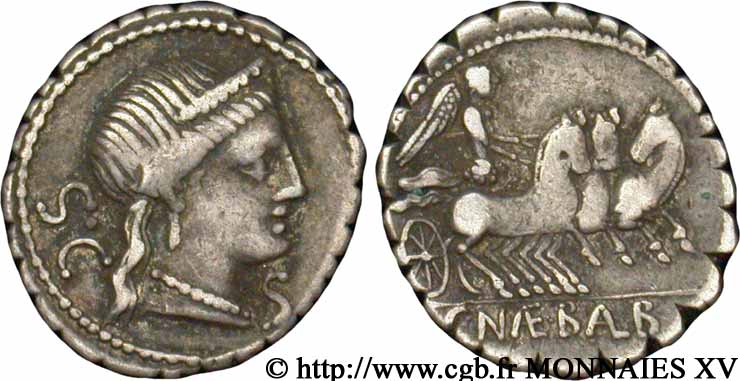
 Segnalare un errore
Segnalare un errore Stampate la pagina
Stampate la pagina Condividi mia selezione
Condividi mia selezione Fai una domanda
Fai una domanda Consegnare / vendere
Consegnare / vendere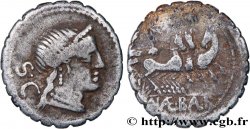
 Descrittivo
Descrittivo